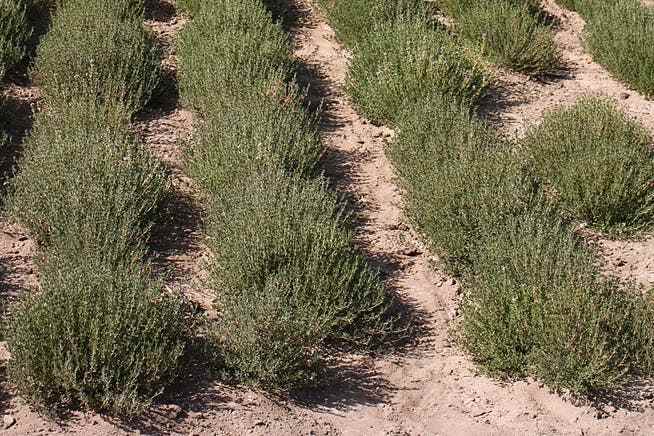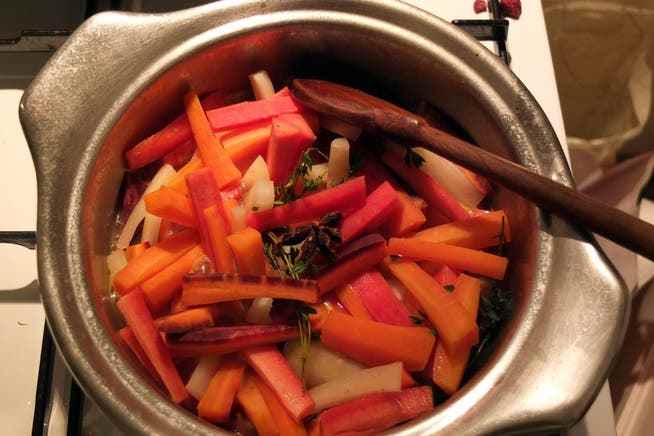In antiquity, thyme was used as a perfume, for burnt offerings and as a medicine. Today, the herb is valued above all in the kitchen, where it primarily accompanies stews with meat.
Thyme only develops its aroma when the sun is shining. If you pick it on a rainy day, you will have little culinary pleasure from it.
The picture that the tourist guide created in front of the Mars temple in the Roman Forum could hardly have been more vivid: “We always chose particularly strong and beautiful bulls. They washed them, then rubbed them from head to toe with thyme, put a sash of gold thread around their necks, led them to the altar, tied them up, and then the ax . . .» He stretched his right hand far into the sky above Rome. The eyes of the whole tour group followed his fingers. “Oi, oi, oi, zack!” The hand went to the ground. Everyone looks after her. “With one blow the priest separates the head from the neck!” A shudder ran through the group. The men were the first to recover, pointing the cameras at the ruins as if in a trance, documenting the place of horror.
It’s been a few years since I observed this Guida turistica. But he probably still tells the story that way. Tourist guides like to embellish their depictions – this increases the tip. It seems proven that bulls were killed with an ax in the Roman Forum. But do you smear such a sacrificial animal with thyme before its ascension, as if it were a roast for the gods? I couldn’t find any reference to it in my books.
On the other hand, we know that people in antiquity liked to rub themselves with thyme. For example, Antiphanes describes a wealthy Greek who “perfumed his knees and neck with an essence of ground thyme.” Thyme was often used as a burnt offering to appease the gods. Hence its name, derived from the Greek word thyein («to smoke, to incense, to offer a sacrifice»).
However, the ancient authors repeatedly confused the true thyme (Thymus vulgaris) with other plants. So the widespread opinion that thyme originally came from Mesopotamia is probably wrong, because that’s where it definitely doesn’t grow “far and wide” today, as the biologist Hansjörg Küster writes. To make matters worse, thyme has a few brothers and sisters, almost all of whom smell wonderful, albeit all slightly different: caraway and lemon thyme, for example, or quendel, the wild or field thyme (Thymus serpyllum).
Thyme has three characteristics that set it apart from many other spices. First, almost like wine, it responds to terroir. Which means that the scent and taste of the spice can vary greatly depending on where the thyme grows. Against this background, one can also understand how various ancient poets were able to sing about the thymus from Mount Hybla in Sicily. And the phenomenon explains why experienced spice collectors taste the thyme before putting it in their bags.

Thyme also grows excellently in sandy soil.
Second, thyme only develops its aroma when the sun is shining. If you pick it on a rainy day, you will have little culinary pleasure from it. And third, the herb develops an even stronger perfume when dried, which is otherwise only the case with oregano and rosemary.
Everything about the thyme plant is aromatic, but primarily the branches densely covered with small leaves or just the plucked leaves are used. They often have a strong, celebratory scent reminiscent of wet wood smoke. You can also discover notes of caraway in it or think of pizza and pine forests. The gastrosophist Deon Godet allows himself to be carried away to a veritable psychogram of the thyme flavor and comes to the conclusion: “Anyone who smells the thymus easily believes that everything is changing for the better.”
So the sheer life. That said, when thyme is in the air, I almost inevitably think of the tourist guide and his rubbed bull. You just can’t get something like that out of your head. And the combination of animal, death and thyme is something of a kitchen classic, since the mint is one of the most important herbs in the preparation of meat. It plays its best cards in dishes that simmer for a long time, because thyme is one of those rare spices that don’t lose their power the first time they come into contact with heat, but rather gradually release some of their aromas into the food. This is why thyme is undoubtedly an integral part of the famous bouquet garni, without which every French casserole feels criminally left alone.
However, fresh thyme in particular does not have to be stewed at any price, it also makes a good dose in salads, for example, and forms an almost heavenly combination with goat’s cheese, black olives or lemon.
I treat myself to a special treat in summer in the mountains, where a small, often highly aromatic thyme grows in almost every meadow. I then pluck out a goodly number of straws and pack them in the mesh pocket of my backpack. From that moment on, not only does its scent accompany me, my mouth also regularly waters, as if I can already smell the roast, which I will season with the herb in the evening.
However, when I see a happy alpine calf happily rolling around in a pasture with thyme, then the Corinthian columns of the Mars-Ultor temple fade into the most peaceful mountain idyll like evil giants. And I see the hand of the Guida in the sky: «Oi, oi, oi . . .»
Carotte’s Ducele

With the Carottes Ducele, the combination of thyme and star anise has an amazing aromatic effect.
Thyme goes well with carrots, but if you add star anise, like chef Auguste Ducele, it takes on an unusual splendor.
Ingredients (for 2 to 4 people)
- 200 ml light broth
- 500 g carrots, cut into sticks 5 cm long
- 4 sun-dried tomato halves, cut into strips
- 1 small dried chilli, crumbled
- 2 star anise
- 3 cloves of garlic, lightly crushed
- 4 sprigs of thyme
preparation
- Bring the broth to the boil, add the carrots, tomatoes, chili, star anise, garlic and thyme.
- Put the lid on and cook on low for 15 to 20 minutes. Stir regularly.
- Towards the end of the cooking time, remove the lid to reduce the liquid a little.
Kawotaise
One of my favorite thyme recipes is Kawotaise, a sweet potato and carrot dip combined with lots of thyme, some cardamom and various citrus flavors.
Ingredients for 4 persons)
- 1 large sweet potato (150 g), peeled, cut into pieces
- 4 carrots (300 g), peeled, cut into ½ cm slices
- 3-4 cardamom, seeds removed from the pods and crushed
- 3 sprigs of thyme
- 1 tbsp lemon juice
- 1 tbsp orange juice
- 1 tbsp lemon zest (corresponds to the zest of ½ lemon)
- 1 tbsp orange zest (equivalent to the zest of ¼ orange)
- 1 tbsp olive oil
- ½ tsp chilli flakes
- ¼ tsp salt
preparation
- Wrap the sweet potato, carrots, cardamom and thyme in a piece of aluminum foil – or in a bag made of baking paper that you can tie with string. Place packet in center of 450ºF oven and cook for 45-50 minutes. In order for the ingredients to soften, you should form a rather flat package and seal it well.
- Take the package out of the oven, open it and let the contents cool down a bit. Strip and discard the thyme sprigs.
- Put the carrot and potato pieces in a large soup plate, drizzle over the lemon and orange juice. Mash everything with a fork until smooth. Depending on how moist the potato-carrot mixture is, you may need a little more or less juice.
- Fold in the lemon and orange zest, olive oil, chili flakes, and salt. Work through everything again.
- Serve with toasted bread slices, raw vegetables, smoked fish, black olives, cheese, sausage, etc.
